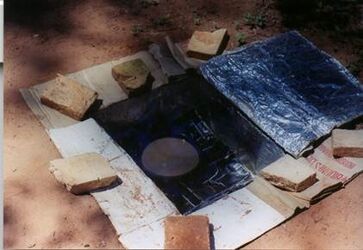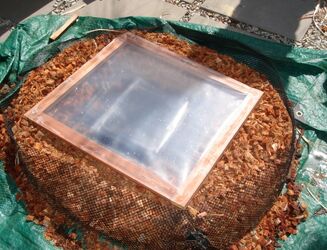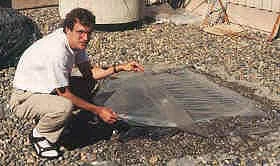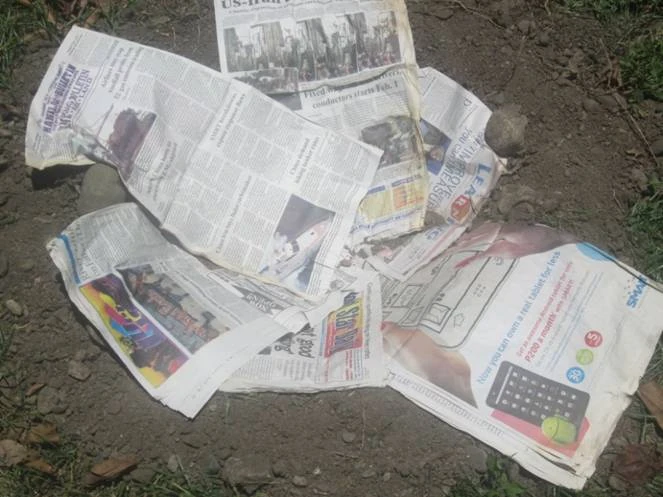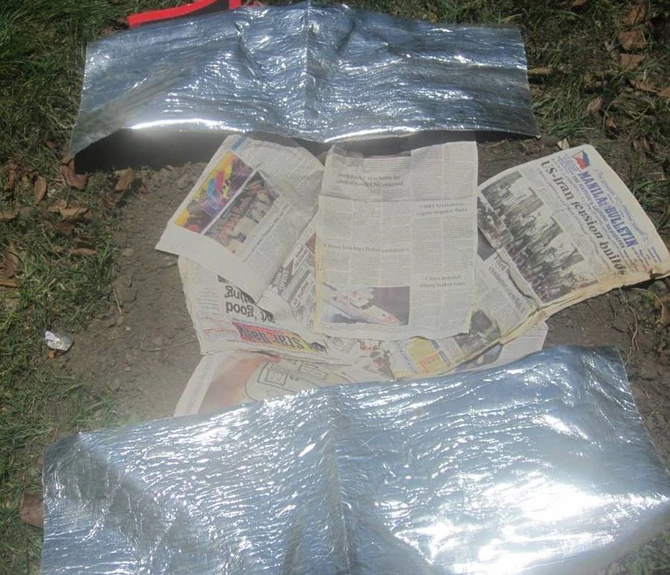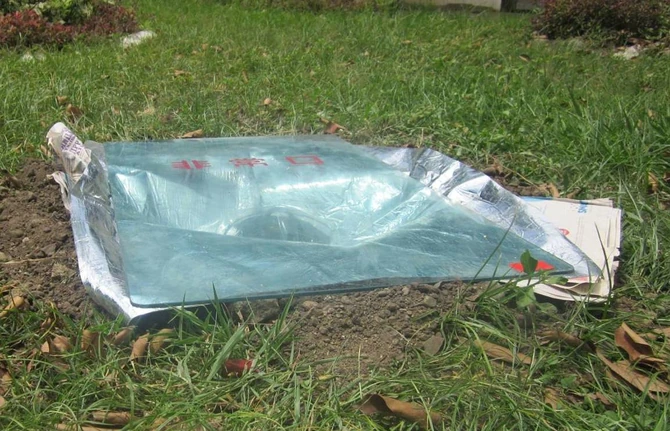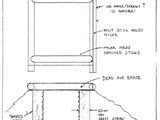Tom Sponheim (talk | contribs) mNo edit summary |
Tom Sponheim (talk | contribs) mNo edit summary |
||
| (32 intermediate revisions by 3 users not shown) | |||
| Line 1: | Line 1: | ||
{{GoogleTranslateLinks}} |
{{GoogleTranslateLinks}} |
||
| + | {{Updated|12|15|23}} |
||
| + | [[File:Basin-from-above-web.jpg|thumb|300px|[[Bjorn Qorn]] have used a large in-the-ground solar cooker to produce their solar-roasted coffee for sale.]] |
||
| ⚫ | '''In-the-ground solar cooker designs''' use a hole in the ground to replace the box container of a typical [[solar box cooker]], or to provide support for the reflectors of a [[:Category:Solar panel cooker designs|solar panel cooker]] or a [[:Category:Parabolic solar cooker designs|parabolic solar cooker]]. This simplifies construction, but the approach has some limitations. If trying to replicate a box cooker, some form of insulation, possibly leafy ground cover, will be required to line the sides and bottom of the hole. |
||
| + | __TOC__ |
||
| + | ==History== |
||
| ⚫ | |||
| ⚫ | |||
| ⚫ | |||
| ⚫ | In-the-ground solar cooker designs |
||
| ⚫ | |||
| − | |||
| ⚫ | |||
| ⚫ | |||
| − | |||
| ⚫ | [[John Barker]] has done considerable research with the [[Solar Nest]]. He has experimented using netted bags of coconut husks to mimic digging into insulating ground cover. Others, such as |
||
| − | |||
| ⚫ | The [[Solar puddle]] is a [[water pasteurization]] technique based upon the research of [[Dale Andreatta]] for large amounts of water. It is essentially a puddle of water |
||
| ⚫ | |||
| ⚫ | |||
Solar Nest with plastic wrap top 2.jpg|The [[Solar Nest]] by [[John Barker]]. |
Solar Nest with plastic wrap top 2.jpg|The [[Solar Nest]] by [[John Barker]]. |
||
Solar puddle.jpg|[[Solar Puddle]] based upon the research of [[Dale Andreatta]]. |
Solar puddle.jpg|[[Solar Puddle]] based upon the research of [[Dale Andreatta]]. |
||
| + | Basin-from-above-web.jpg|[[Bjorn Qorn]] uses a large in-the-ground solar cooker to produce their product for sale. |
||
| + | Parabolic Earthen Solar Cooker2.jpg |
||
</gallery> |
</gallery> |
||
| − | Most of the designs have used the box cooker approach. However, a panel cooker may have possibilities. Staff at [[Solar Cookers International]] have considered lining a hole with a mylar reflective 'space' blanket. The material dug from the hole could be built up to create a circular reflector around the hole. Then, typical of a panel cooker, a black pot in a plastic bag on a slightly raised platform, is placed at the center. While it would not be possible to redirect the reflectors, it is conceivable that two holes might be dug side by side, with one cooker directed to morning sun and the other at afternoon sun. A trench dug between the two cookers would also make it easier for the user to easily reach the cook pot. This approach would be particularly useful for locations near the equator. More research should be done with space blankets used as reflectors. They are available commercially for approximately $5 USD. |
||
Soil consistency will also be a factor, as soil too sandy may not support the reflector blanket. Soil type is also a factor for the box style cooker, as unless the walls are supported, the soil may cave-in on the sides. |
Soil consistency will also be a factor, as soil too sandy may not support the reflector blanket. Soil type is also a factor for the box style cooker, as unless the walls are supported, the soil may cave-in on the sides. |
||
| + | |||
| + | ==Resources== |
||
| + | ==={{HeadingDocuments}}=== |
||
| + | *'''August 2012:''' [[Pete Schwartz]] discusses fixed reflectors in his paper, [http://www.sciencedirect.com/science/article/pii/S0038092X11003380 Concentrating sunlight with an immobile primary mirror and immobile receiver: Ray-tracing results] |
||
| + | ===Audio and video=== |
||
| + | *{{NewOct19}}'''June 2019:''' |
||
| + | ::[[File:أدرار النهار تنقل تجربة الطهي تحت أشعة الشمس الحارقة|none|thumb|400px|Cooking by burying the pots under the ground in a desert environment]] |
||
| + | |||
| + | ==Hole in the ground using an emergency blanket== |
||
| + | This proposed design makes use of a reflective sheet (emergency or "space" blanket) and a clear plastic sheet as the [[glazing]]. A hole in the ground replaces the structure of a normal solar cooker. |
||
| + | [[File:Hole-in-ground_spaceblanket.gif|none|600px]] |
||
| + | [[Paul van den Hurk]] dug a round hole in the ground about 30 inches diameter and about 1 foot deep. He made the sides about 60° and covered them and the bottom with old newspapers. Then he covered the newspapers with some old aluminum foil. He placed a black-painted cooking [[pot]] with [[rice]] inside and covered it all with a piece of glass. It took about 2 hours to cook the rice. See images below: |
||
| + | |||
| + | |||
| + | <gallery type="slider" orientation="bottom" captionalign="left"> |
||
| + | File:Dig_a_hole.jpg|Dig a hole. |
||
| + | File:Cover_with_newspaper.jpg|Cover with newspaper. |
||
| + | File:Cover_with_foil.jpg|Cover with foil. |
||
| + | File:Cover_with_a_glass.jpg|Cover with a glass. |
||
| + | File:That's_it.jpg|That's it! |
||
| + | </gallery> |
||
| + | =={{NewMar20}}Household Solar Energy Bank== |
||
| + | [[File:Household_solar_energy_bank_03-20.png|thumb|350px|none|A [[Household Solar Energy Bank]] heating buckets of water.]] |
||
| + | {{PlansInCategory}} |
||
[[Category:Solar cooker designs]] |
[[Category:Solar cooker designs]] |
||
Latest revision as of 15:54, 4 March 2024
|
Last edited: 15 December 2023
|
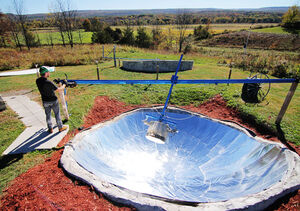
Bjorn Qorn have used a large in-the-ground solar cooker to produce their solar-roasted coffee for sale.
In-the-ground solar cooker designs use a hole in the ground to replace the box container of a typical solar box cooker, or to provide support for the reflectors of a solar panel cooker or a parabolic solar cooker. This simplifies construction, but the approach has some limitations. If trying to replicate a box cooker, some form of insulation, possibly leafy ground cover, will be required to line the sides and bottom of the hole.
History[]
California researcher, Said Shakerin, researched an early design that used a black insulating mat at the bottom of the hole, with a glazing cover and reflector on top. His findings can be read here: Earthen Solar Cooker
John Barker has done considerable research with the Solar Nest. He has experimented using netted bags of coconut husks to mimic digging into insulating ground cover. Others, such as Kristen Rahn, have used newspaper for insulating the cooking chamber.
The Solar puddle is a water pasteurization technique based upon the research of Dale Andreatta for large amounts of water. It is essentially a puddle of water within a greenhouse which is heated to at least 70 °C (158 °F)
Soil consistency will also be a factor, as soil too sandy may not support the reflector blanket. Soil type is also a factor for the box style cooker, as unless the walls are supported, the soil may cave-in on the sides.
Resources[]
Documents[]
- August 2012: Pete Schwartz discusses fixed reflectors in his paper, Concentrating sunlight with an immobile primary mirror and immobile receiver: Ray-tracing results
Audio and video[]
- June 2019:
Hole in the ground using an emergency blanket[]
This proposed design makes use of a reflective sheet (emergency or "space" blanket) and a clear plastic sheet as the glazing. A hole in the ground replaces the structure of a normal solar cooker.
Paul van den Hurk dug a round hole in the ground about 30 inches diameter and about 1 foot deep. He made the sides about 60° and covered them and the bottom with old newspapers. Then he covered the newspapers with some old aluminum foil. He placed a black-painted cooking pot with rice inside and covered it all with a piece of glass. It took about 2 hours to cook the rice. See images below:
Household Solar Energy Bank[]
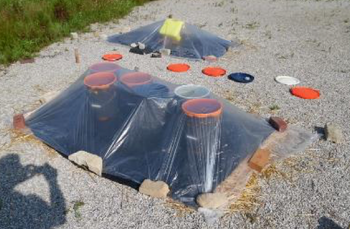
A Household Solar Energy Bank heating buckets of water.
All construction plans[]
All designs[]
- See below:
All items (8)


